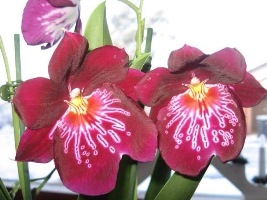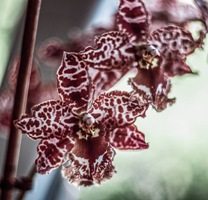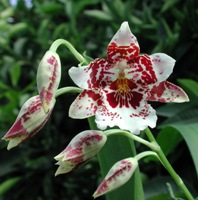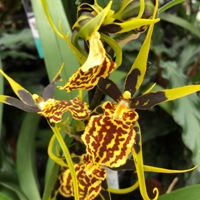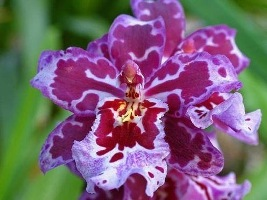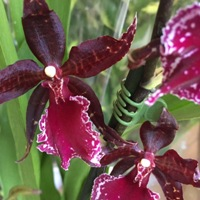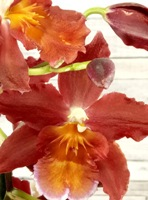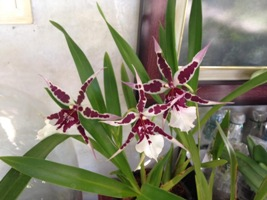December, 2019

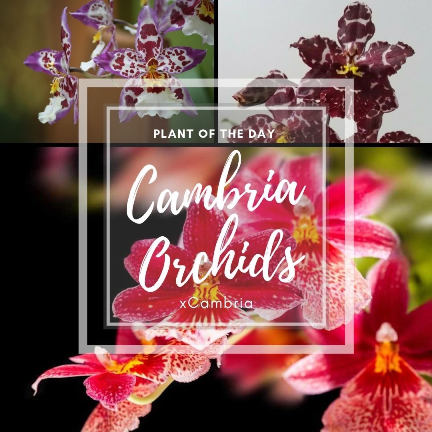
Marketing picture for Cambria orchids, from a garden center. The accompanying text says "Cambria orchids are any orchids that are formed from 2 or more orchid genuses. They are bred with the goal of making a hardier orchid that's easier to care for."
What's All This I Hear about Cambria Orchids?
Updated April, 2021 with new information about the fate of the original Vuylstekeara, and September, 2021 with new information about the pedigree of Vuylstekeara Cambria!
Someone on Facebook claimed to be growing "Cambria orchids". From the picture, they were obviously talking about some sort of Oncidium intergeneric hybrid, but where did the term "Cambria orchid" come from? We investigated. It turns out orchid hobbyists in many areas are familiar with this term, even if they may have little idea of what it means. Here in Southern California, we don't seem to encounter this term, even at the grocery and home improvement stores where orchids are marketed to the general public. But the situation appears to be much different in the rest of the world, especially in Europe.
With some digging, we have found part of the story. We can tell you what the first "Cambria orchid" was, and how the term is used today. There's still a big missing piece: How was the term introduced into commerce? By what company? When? Where? We would love to know!
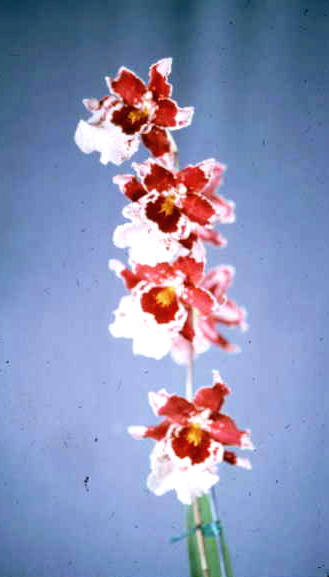
© 1972 AOS, photographer unknown
1972 award photo for Vuylstekeara Cambria 'Plush' AM/AOS
The original "Cambria" was Vuylstekeara Cambria, a hybrid originated in England by Charlesworth & Co. in 1931. The cultivar 'Plush' has received some major awards, such as FCC/RHS in 1967 and FCC/AOS in 1973. 'Plush' also received the RHS "Award of Garden Merit" in 1993, in effect a recommendation of suitability and commercial availability for home orchid growers in the UK.
The intergeneric name Vuylstekeara was created in 1911 for intergeneric hybrids obtained by the combination of Odontoglossum, Miltonia, and Cochlioda. This name is famous today as the first tri-generic hybrid in the Oncidium alliance. It was not the first tri-generic orchid hybrid genus name, that honor goes to Sophrolaeliocattleya, established in 1897. But many of you can see where this story is headed! There are no longer, officially, any Odontoglossums, because those that remained after the first rounds of taxonomic upheaval have now been submerged into the genus Oncidium. The same thing has happened to Cochlioda. Meanwhile, a large part of Miltonia was split out as Miltoniopsis, which has always struck us as amusing, since Miltoniopsis means precisely "looks like Miltonia", and the species involved are exactly what we still think of when someone says Miltonia. So the name Vuylstekeara is no longer an official orchid name, and few people remember Charles Vuylsteke, the talented grower from Loochristi, Belgium who created legions of wonderful Odontoglossum hybrids decades before there was any way to germinate orchid seeds except by sowing them on moss.
However, when we look more closely at the beginnings of Vuylstekeara, the complications quickly set in. Vuylsteke called his first tri-generic hybrid Insignis. It made a sensation at the annual Royal Horticultural Society orchid show at Temple Gardens in 1911. There were several mentions of it in The Orchid Review and elsewhere.
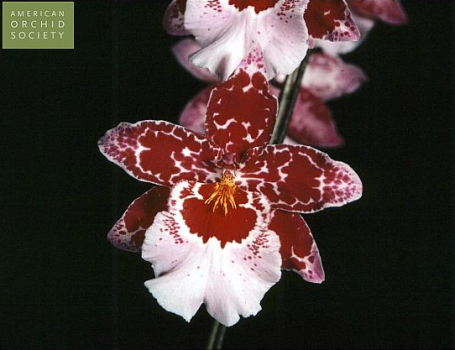
© 1988 AOS
Award photo of what is now Oncidopsis Cambria 'Mayfield' AM/AOS, 89 points, 1988, photographer not identified
Orchid Review 19:60 (1911): VUYLSTEKEARA INSIGNIS.
Some months ago a striking hybrid raised by M. Ch. Vuylsteke from Miltonia vexillaria ♀ and Odontioda Vuylstekeæ ♂ flowered in his establishment at Loochristi, Ghent, of which a short notice and a coloured figure of a single flower appeared (Rev. Hort. Belge, 1910, p. 150, with fig.). As three genera were involved, the question of a suitable name has been in abeyance, but now that the Report of the Committee appointed to deal with the question of the nomenclature of multigeneric hybrids has appeared (see pp. 7, 8 of our last issue), we may proceed to apply the Committee’s recommendations to the present subject. One clause reads: “Future generic hybrids (combining three or more genera) should be given a purely conventional name consisting of the name of some person eminent as a student or grower of Orchids, terminated by the suffix ‘ara.’ ” The generic name now proposed for the present plant is, we think, highly appropriate, for not only the hybrid but also the pollen parent are the creations of M. Vuylsteke, who has further raised a host of beautiful hybrid Odontoglossums which now decorate our gardens. The specific name is also appropriate, and in conformity with the recommendations of the Committee, that it “should be preferably in the Latin form.”
M. Vuylsteke has certainly raised a striking hybrid, which, from its composition, should develop into a handsome thing when the plant becomes strong. The flower is fairly intermediate in character, with the expanded form of the seed-bearer, and a four-lobed lip. It measures just under two inches from tip to tip of the petals, and the colour may be described as carmine-rose, with the lip slightly paler, especially towards the base, and the crest bright yellow. Nothing is stated as to the habit of the plant. We hope to be able to examine it on some future occasion. Vuylstekeara will, according to the rule cited, include all the combinations between the three genera Cochlioda, Miltonia, and Odontoglossum, and thus the name must also be applied to any future hybrids between Miltonioda and Odontoglossum, and between Odontonia and Cochlioda, as well as to the two above mentioned.
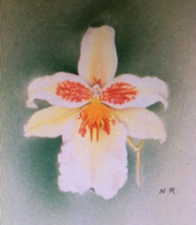
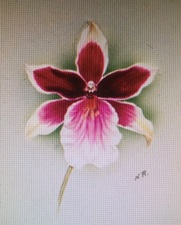
© RHS
RHS award paintings by Nellie Roberts: Vuylstekeara Insignis (Lambeau) AM/RHS 1914, and Insignis var. picta AM/RHS 1923 — neither one matches the description of the original Insignis exhibited in 1911 by Vuylsteke
However, when Vuylstekeara Insignis was awarded in 1914 and 1923 by the Royal Horticultural Society, the parentage was listed as Miltonia Bleuana × Odontioda Charlesworthii. See Orchid Review 22:219 and 31:252. From the descriptions of this Insignis, it appears to be a completely different plant: (1914) “A distinct and striking novelty, bearing flowers most like the Miltonia parent in shape, and the colour primrose yellow, with a cluster of light brown nearly confluent blotches on the lower half of the petals, and the crest of the lip orange, with a zone of short brown lines around it. Exhibited by M. Firmin Lambeau, Brussels.” (1923) “Award of Merit. Vuylstekeara insignis picta (Miltonia Bleuana × Odontioda Charlesworthii); from Messrs. Charlesworth & Co. A very much finer variety than the original one flowered by Mons. Lambeau in 1914. In the variety picta the spike carried five flowers of medium size, the sepals and petals rather narrow, but heavily stained with blood-red colour, the expansive labellum prettily tinged with varying shades of rose.”
This sort of nomenclatural appropriation was fairly common in that period, when multiple hybrids of different parentage were registered (even by the same grower!) under the same name. The RHS orchid register shows three entries for Oncidopsis Insignis, formerly registered as Vuylstekeara Insignis:
- Oncidopsis Insignis (1911), registered and originated by Vuylsteke, parentage Oncidium noezlianum × Miltoniopsis vexillaria.
- Oncidopsis Insignis (Vuylsteke), registered in 1911 by Vuylsteke, originated by Vuylsteke, parentage Oncidium noezlianum × Miltoniopsis vexillaria.
- Oncidopsis Insignis (Lambeau), registered in 1914 by Lambeau, originated by Lambeau, parentage Miltoniopsis Bleuana × Oncidium Charlesworthii (1908).
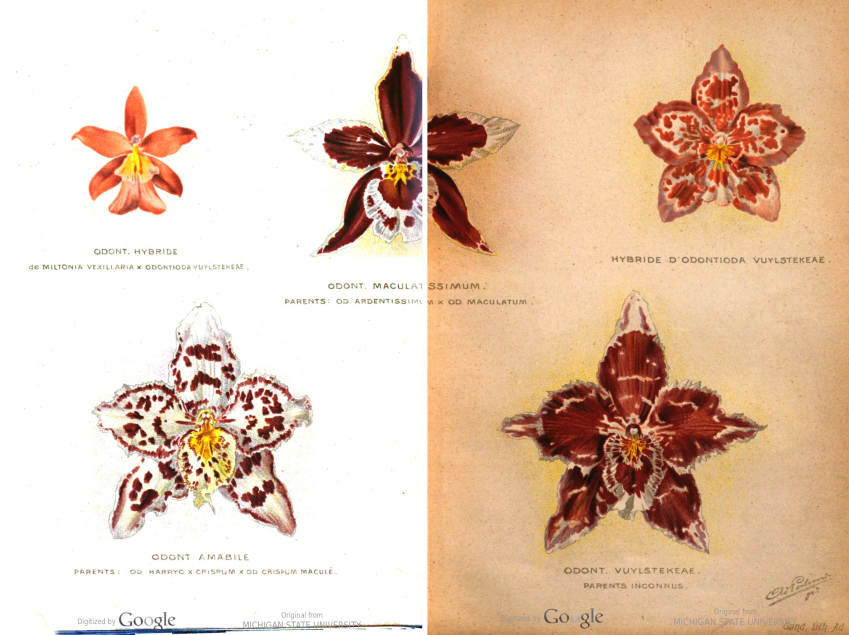
Color plate from Revue de l'horticulture belge et étrangère (1910) 36, reassembled from online digitized images. The top left illustration is the flower that was later registered as Vuylstekeara Insignis. The top right illustration, in spite of the confusing label, appears to be Odontioda Vuylstekeae, one parent of the new Insignis — very similar illustrations of the same Odontioda exist in several other sources.
We attempted to locate the first mention of Vuylsteke's plant, in Revue de l'horticulture belge et étrangère. The required volume had been digitized by Google from the libraries of the University of Michigan, but the color plate accompanying the short article had not been unfolded when the digital photograph was made. We attempted to locate a copy in the Los Angeles area, but then all of the libraries shut down because of the pandemic. The next time we searched, a year later, success! Google had digitized another copy of the same volume, from Michigan State University, and this time the color plate was unfolded and rendered as two separate images that we were able to stitch together. At last, we know what Vuylsteke's plant looked like, although there are some additional problems with labels of the other illustrations in the same plate. The article itself was the work of Louis De Nobele of Ghent, Belgium, who probably had met Vuylsteke, but the author does not quote Vuylsteke, nor betray any indication that he had detailed information about these plants, apart from the fact that someone had painted them from life.
For the parentage of Odontioda Vuylstekeae, the pollen parent of the first Vuylstekeara, we found the following account in Orchid Review 12:162 (1904): “The Temple Show furnishes another remarkable example of progress in hybridisation, and once more from the establishment of M. Ch. Vuylsteke, of Loochristi. This exhibitor sent a very handsome hybrid between Odontoglossum Pescatorei and Cochlioda Nœtzliana, in which, curiously enough, the shape of the Odontoglossum was largely reproduced, but the colour was a remarkable combination of shades of rose and salmon red, with some cream colour on the lip. It was the sensation of the show, and received a First-class Certificate, to which the Council afterwards added the rare honour of a Silver-gilt Lindley Medal—“for progress,” I think it might be defined. In any case it was highly appropriate, for the award was to be given preferentially for “excellence in cultivation,” and it is probably this more than anything else which has enabled M. Vuylsteke to overcome the difficulties of bringing seedling Odontoglossums through their early stages that has contributed so much to his success. I am forgetting the name given, which was Odontioda × Vuylstekeæ, the useful plan of compounding a generic name from that of its two parents having been followed.”
A further account of the same show in the same volume calls it the seventeenth Great Annual Temple Show, opening on Tuesday, May 31, 1904 in the Inner Temple Gardens, and notes that Odontioda × Vuylstekeæ was the sensation of the show.
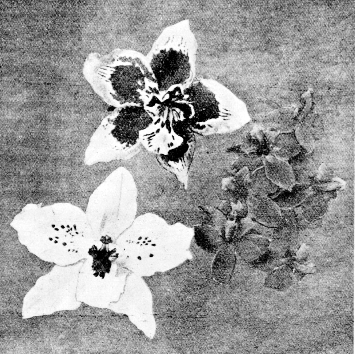
Plate from Orchid Review 12:209 (1904): Top, Odontioda × Vuylsteckeæ; left, Odontoglossum pescatorei; right, Cochlioda nœtzliana
We know exactly what this Vuylstekeæ was, for it was the subject of a separate article in Orchid Review the next month (12:209-211, July, 1904), including a photograph and a detailed description of both of its parents. Moreover, the awarded flower was painted by Nellie Roberts, and the parentage shown for this FCC matches that given above, but does not match any of the registration records shown in the current RHS orchid register database — for that, we have to peel away more changes in taxonomy.
For Charles Vuylsteke, “The Man and the Hybrid Genus Vuylstekeara”, see Orchid Digest 58(3), 1994.
What should we call these hybrids today?
Odontoglossum pescatorei is regarded as a synonym of Odontoglossum nobile, which has since become Oncidium nobile. Cochlioda nœtzliana was correctly spelled noezliana, and has since become Oncidium noezlianum. Therefore, Odontodia Vuylstekeæ is now Oncidium Vuylstekeae, but Monsieur Vuylsteke appears to have registered two different hybrids called "Vuylstekeae". The one in question, originally registered as Odontioda Vuylstekeae, is (now) Oncidium Vuylstekeae (1904); the other one, originally registered as Odontoglossum Vuylstekeae, is now Oncidium Vuylstekeae (1905), with parentage originally listed as Odontoglossum Crispo-Harryanum × Vuylstekei.
Then what becomes of the original Vuylstekeara Insignis? The parentage is now transformed into Miltoniopsis vexillaria (because the species that “look like Miltonias”, the literal translation of Miltoniopsis, have been split from Miltonia) × Oncidium Vuylstekeae (1904), and the hybrid genus is now Oncidium × Miltoniopsis = Oncidopsis. The official abbreviation, by the way, is Oip. — look for it everywhere. This brings part of the story down to the present.
But the reign of Vuylstekeara Insignis (1911) as the first tri-generic hybrid in the Oncidium alliance was brief. By May, 1912, its parentage had been questioned and determined to be in error. A look at the original illustration (above) will suggest why: The flower looks like what you would expect if you crossed Miltonia vexillaria with Cochioda noezliana (using the old names). There are none of the attributes expected from an Odontoglossum parentage, such as ruffles and spots. On the occasion of the Royal International Horticultural Exhibition of 1912, the Orchid Review simultaneously dethroned the first Vuylstekeara and installed another:
Orchid Review (1912) 20:171, in the course of a report on the Royal International Horticultural Exhibition, which opened on May 22, 1912, in the grounds of the Royal Hospital, Chelsea:
Vuylstekeara Hyeana.—A striking hybrid derived from Odontonia Lairesseæ and Cochlioda Nœtzliana was exhibited by M. Jules Hye de Crom at the Royal International Exhibition, and being derived from Cochlioda, Miltonia, and Odontoglossum, must be referred to the hybrid genus Vuylstekeara (see page 60 of our last volume). The plant bore a branched panicle of flowers, most like those of the Odontonia parent, but the lip smaller and more like that of the Cochlioda in shape. The flowers are blotched with salmon-red, on a paler ground, the disc of the lip yellow, and the apex white, with a transverse white line behind the apex. We are informed that the original Vuylstekeara insignis was based on an erroneous record, the parents being Miltonia vexillaria and Cochlioda Nœtzliana, hence the plant becomes a synonym of Miltonioda Harwoodii.
So it was that Vuylstekeara Insignis, the first tri-generic hybrid in the Oncidium alliance, was dismissed as an impostor, and replaced by Vuylstekeara Hyeana, of which no illustration, plant, or offspring is known to exist. Confusingly, the original registration remains, but the parentage was altered. It was only through the assistance of Julian Shaw, the RHS Orchid Registrar, that we found the synonymy with the old Miltonioda (modern Oncidopsis) Harwoodii. Another feature of this episode that seems to us quite unorthodox, is that the name Vuylstekeara was created for a hybrid that did not meet the stated criteria of ancestry from three genera. When this mistake was discovered, you might think the generic name, too, would then be invalidated, having been created, we might say, under false pretenses. But instead, the name was kept, and applied to the next suitable hybrid that came along.
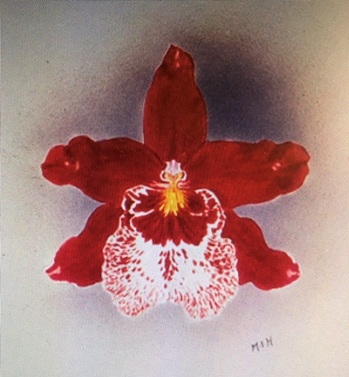
© 1967 RHS
Award painting by M. Iris Humphreys for (then) Vuylstekeara Cambria 'Plush' FCC/RHS, 1967
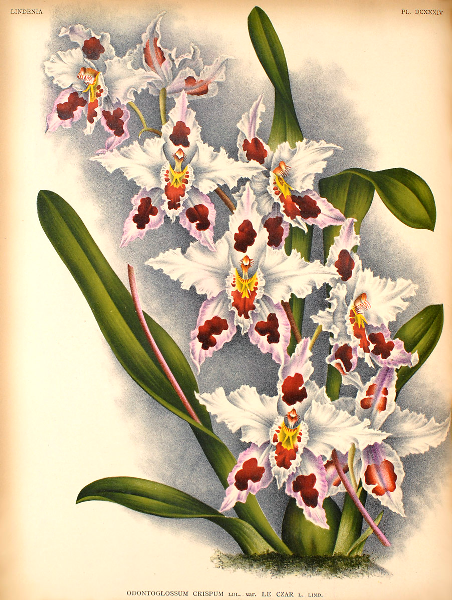
Odontoglossum crispum var. Le Czar, from Lindleyana, 1898 — not the same Czar that figures in the pedigree of Cambria!
Now we can consider the famous Vuylstekeara Cambria, and its highly awarded cultivar ‘Plush’. The parentage of Cambria is now listed as Oncidopsis (originally Vuylstekeara) Rudra × Oncidium (originally Odontoglossum) Clonius. Both parents are mainly red, with good form for their type of breeding.
A cultivar of Vuylstekeara Rudra, 'Atlas', received AM/RHS in 1928, and was painted by Nellie Roberts. Its ancestry is completely documented, a combination of old Odontoglossum hybrids with what were then Cochioda noezliana and Miltonia vexillaria.
Clonius (a cultivar 'Colossus' received AM/RHS in 1938 and was painted by Nellie Roberts) is Aquitania × The Czar, but then we lose the trail. RHS seems to have no record of the parentage of Aquitania, nor of The Czar.
Aquitania was exhibited by Charlesworth & Co. at the Spring Show of the Royal Horticultural Society (the same show formerly known as the Temple Show) in May, 1913, so we can be fairly sure it is one of Charlesworth’s Odontoglossum hybrids. The Czar is even more obscure, as we were not able to locate a clear record of it being exhibited or awarded. We wondered if it might be the plant in a famous print of Odontoglossum crispum Lindley var. Le Czar, issued in 1898. “Le Czar” is not actually a French name, the French spelling is Tsar! Perhaps The Czar in the ancestry of Cambria was simply the same notable specimen of Oncidium crispum illustrated by Lindley, a species now regarded (at least by some) as Oncidium alexandre?
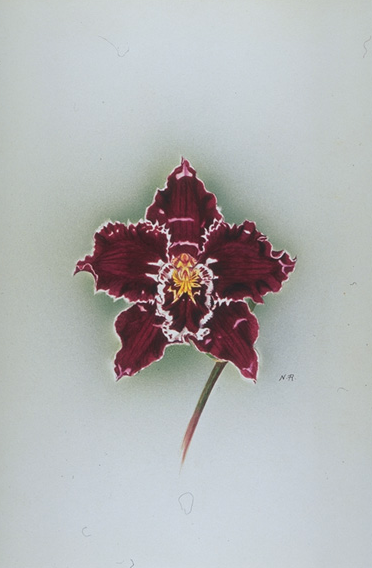
© RHS
Odontoglossum The Czar FCC/RHS, painting by Nellie Roberts
But that cultivar turned out to be the wrong Czar! Apparently, Czars were fashionable at a certain period, and a lot of things, including orchids, came to be named after them. An astute reader of this blog, Minh-Cuong Nguyen of Toronto, Canada, spotted Odontoglossum The Czar in a report of orchid judging in The Orchid World 6:162 (1916): "Royal Horticultural Society. March 7th, 1916. Members of the Orchid Committee present: J. Gurney Fowler, Esq. (in the chair), Sir Jeremiah Colman, Bart., Sir Harry J. Veitch, Messrs. Jas. O'Brien (hon. sec.), W. Bolton, R. Brooman-White, Stuart Low, Gurney Wilson, T. Armstrong, J. Charlesworth, J. Cypher, W. H. Hatcher, S. W. Flory and C. Cookson. First-class Certificate. Odontoglossum The Czar (parentage unrecorded), from Messrs. Charlesworth and Co. One of the finest hybrid Odontoglossums yet seen, the flowers being large, or good shape, rich claret-red, with a glowing tint. The large lip bears an immense blotch, and this, as well as other characteristics, suggests with influence of O. Vuylstekei." This award was given two years before the currently recorded registration date of 1918. In fact, this FCC/RHS for The Czar was also documented in a painting by Nellie Roberts. We had missed the award and the painting on the 2003 CD edition of the RHS Orchid Awards, because it was placed in the index between Odontoglossum hybrids Cythera and Daumanda, alphabetizing it as Czar rather than The Czar. From the painting, this was clearly one of the reddest Odonts ever, a trait carried down to its grandchild Cambria. In fact, The Czar, in spite of its undistinguished origins, turns out to be the progenitor of at least 2,100 hybrids, including another of the most famous of the "modern" Oncidium intergenerics, Aliceara Marfitch.
We return to the Wikipedia and other sources that tell us a “Cambria orchid” is a commercial name for intergeneric hybrids involving Odontoglossum, Oncidium, Miltonia, Cochlioda, and Brassia.
The Odontoglossums, at least those mentioned in the background of Cambria, have been submerged in Oncidium. The Miltonia has been split out as Miltoniopsis (because, literally, it looks like a Miltonia). The Cochlioda in question is now also an Oncidium. There was no Brassia in the ancestry of Cambria, but apparently there are today enough hybrids involving Brassia that resemble Cambria, so it is included as well, on the assumption that some “Cambria” orchids might include ancestry of some Brassia species that have not yet been moved to some other genus, such as Oncidium. Aliceara (=Brassia × the "real" Miltonia × Oncidium) and similar intergenerics seem also to be included.
From what we have seen of the ancestry of Cambria and some of the other Oncidium intergenerics that might be considered “Cambria orchids”, then, we suspect they are mostly Oncidopsis or possibly Brassoncidopsis.
But how can we be sure? Researching plant names can be a full-time occupation if you have even a couple hundred plants. While there is a list of intergeneric names on the web site of the Royal Horticultural Society, we think the vast majority of the intergeneric names on the list are no longer valid for current registrations, because so many of the genera have been reorganized or have vanished entirely. The RHS would be well advised to update the list to flag the “empty” intergeneric names. The RHS also has a list of the official abbreviations for the intergeneric names, but, unfortunately, the abbreviations themselves are not in alphabetical order! (The list claims to be an “alphabetical list of standard abbreviations for natural and hybrid generic names”, but in fact it is the generic names rather than the abbreviations that are in alphabetical order). There are now over 3,000 hybrid genus names and essentially no guidance about how they are to be used. Who will take up the challenge to produce an up-to-date and simple web site that orchid hobbyists can use?
Me Too! — At least some web sites are now using “Cambria Orchids” as a synonym for all Oncidium alliance intergeneric hybrids!
What is the future of orchid hybrid names? Has the current official system managed by the RHS become so cumbersome as to be beyond the comprehension of all but the most highly-trained specialists? Will the apparently successful example of complicated hybrids marketed under a user-friendly name such as Cambria provide the example for marketing other orchids? Will the parentage of orchid hybrids eventually disappear from the public record entirely, as the RHS registration process becomes increasingly irrelevant for commercial horticulture, and even for a significant number of orchid growers who are not persuaded by the unprecedented chaotic avalanche of baffling new orchid names? In the absence of active measures to form a consensus, we should not expect to see this situation improve in the foreseeable future.
A selection of pictures labeled "Cambria orchid" from Facebook. How many do you recognize?
